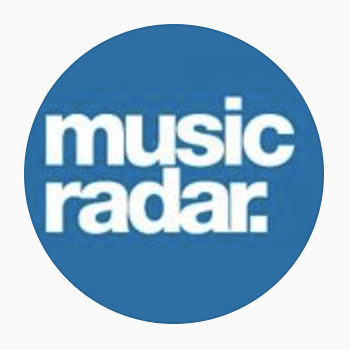28 Telecaster legends: part 1

Jimmy Page
We've covered Les Pauls, Stratocasters, Rickenbackers, Flying Vs and Explorers. Now it's the turn of Clarence Leonidas Fender's pioneering debut solidbody; the Fender Telecaster. First entering production as the single-pickup Esquire and twin-pickup Broadcaster in 1950, for many guitarists, Leo got it right first time.
What follows is part one of a gallery of Telecaster and Esquire-toting gunslingers who have all shaped the face of rock 'n' roll and popular music through a blend of technique, passion and instinct. Oh, and a hell of a lot of great tunes. Without further ado, let's start the ball rolling with Jimmy Page.
Though widely associated with Gibsons (Les Pauls, EDS-1275 double necks), Jimmy Page has made extensive use of Fender Telecasters. The model that saw the most action was a ‘59 or ‘60 Tele gifted to Page by fellow Yardbird Jeff Beck in 1966. Originally painted white, Page added eight reflective circles to it in 1967. He then stripped it down and repainted it himself with a dragon motif - thus, it became his ‘Dragon Tele.’
Page recorded most of Led Zeppelin’s first album with the Dragon (check out this blazing live TV performance of Communication Breakdown from ‘69). But the guitar’s true moment in the sun came when it was used for the solo on Stairway To Heaven (through a Supro amp) - we imagine that you’ve heard it.
In the mid-‘70s, Page acquired a brown ‘53 Tele outfitted with a B-string bender. Known as the ’Brown Bomber,’ it was utilized on tracks like Hot Dog and Ten Years Gone. During much of the ’80s, Page continued to play the Brown Bomber.

Jonny Greenwood
Jonny Greenwood has used Teles since before Radiohead signed to Parlophone in 1991 and the guitars have featured on every one of their albums and (probably) at every live show.
Greenwood’s main guitar (pictured) is a sunburst version one Telecaster Plus. Manufactured from ’89 to ’95, the first incarnation of the Plus featured a modern Strat-style hardtail bridge, Lace Sensor Blue pickup in the neck and two Lace Sensor Reds (Lace’s hottest Sensors) in the bridge, wired together as a humbucker.
Greenwood and Radiohead guitar tech Plank have also added a killswitch and various wiring mods, plus a couple of nice scratchplate stickers. Telecaster number two is a standard American model, heavily modded towards a Plus configuration to replace Jonny’s original Plus of choice which was stolen along with a vanload of gear at a gig in Denver, 1995.
Radiohead co-guitarists Ed O’Brien and Thom Yorke are also fans of all things Telecaster, both having used several throughout the band’s career.

Bruce Springsteen
A true rock ‘n’ roll original, Bruce Springsteen is one of the most documented individuals on the face of the planet.
Surprisingly, the guitar he plays remains something of a mystery. Immortalized on the cover of the Born To Run album, the question persists: Is the guitar a true Fender Esquire, or something else altogether? Experts have analyzed the instrument as if it were the Shroud of Turin.
Bought for $185 in the early ‘70s (“my official you-get-a-record-deal-you-get-a-guitar”) at Phil Pitello’s guitar shop in Belmar, New Jersey, Springsteen liked the Tele because it was light and had feel. Previously, he had played a Les Paul.
From all appearances, the neck is a ’57-‘58 Esquire and the body is from a Telecaster (circa ’60-’63). Little else has been changed to the workhorse guitar (Bruce would add Joe Barden dual-rail single-coil-sized humbuckers in other Telecasters), although in the mid-’80s noted New York luthier Roger Sadowsky did some ’waterproofing’ to the pickups to guard against Springsteen’s profuse sweating during shows.
And for those who doubt The Boss’s skills on the six string, check out his soloing on Adam Raised A Cain. Case closed.

Jeff Beck
When Jeff Beck started his short tenure in The Yardbirds in 1965, he didn’t actually have a guitar to call his own and had to loan the band’s red Tele for early gigs.
Beck played various Telecasters from that point onwards but was put off by the rosewood fingerboards featured on Fender’s new models: “I wanted a maple neck. And the only one I ever saw belonged to John Walker from the Walker Brothers... He wanted £75 – only about £10 cheaper than a brand new one. But he wouldn’t shift.”
Beck bought the guitar anyway – actually a 1954 Esquire rather than a Tele – and set about modifying his new purchase by adding a black scratchplate and replacing the rusted steel saddles with brass ones from another guitar. The Esquire’s peculiar, Strat-like contours sanded into the front and back were actually there before Jeff acquired it.
Fender offered a limited edition, 150-guitar run of the legendary Esquire in 2006, with every one of its numerous modifications and battle scars recreated. The guitar itself currently resides in pickup designer Seymour Duncan’s private collection.
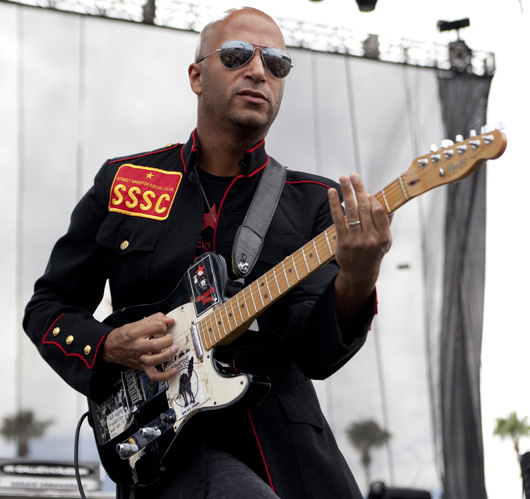
Tom Morello
Morello has sculpted his own unique sound using the same Marshall amp, a small selection of effects and just a handful of guitars over the years. When it comes to drop-D riffing, he turns to a black stock 1982 Telecaster:
“I needed a guitar that I could down-tune, and my roommate at the time traded me his Telecaster for an extra amp that I had, and that became my drop-D guitar.
“It’s ironic as the Telecaster is not a ‘heavy metal’ guitar, yet it was the guitar that played all of the Rage Against The Machine and Audioslave riffs that are in drop-D tuning.”

Keith Richards
Keith Richards has played plenty of guitars over the years, but he’s most readily identified with the Fender Telecaster. From 1975 to well into the 1980s, a black Tele Custom (pictured) was his main standard tuning electric onstage. It also proved useful when discouraging stage invasions.
One of Keith’s most iconic guitars is Micawber, the early 1950s butterscotch Tele he’s owned since Exile On Main St. that’s his number one open-G guitar. Strung with just five strings (G D G B D low-high) and featuring a replacement brass six-saddle bridge and a Gibson PAF in the neck position, if one guitar is the sound of The Rolling Stones, it’s this.
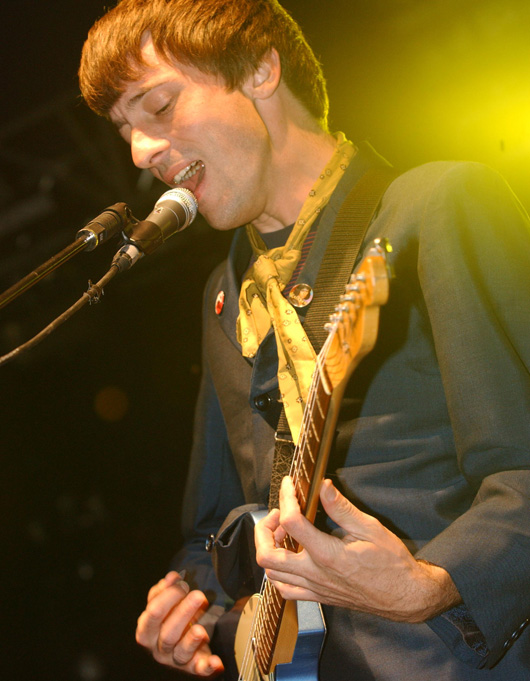
Graham Coxon
Blur guitarist and solo artist Coxon’s first encounter with the Telecaster came via a longtime friend and collaborator, producer Stephen Street: “Stephen lent me his Tele. He’s got a lovely old Telecaster, and that was it. As soon as I played that, I couldn’t believe it. It was something about the slimness of the neck.
“And what a tough little thing it was, and what a ring-y sound it had. It had the sort of ring I liked with The Jam and The Who. But it also had a really good punch. It was so comfortable; I really couldn’t quite believe it. Now I’m just a Telecaster maniac, I suppose…”
Coxon’s main Blur guitars were USA ’52 reissues, while these days he uses a variety, including a blonde ’68 model with a Gibson PAF at the neck, and a lake placid blue ’60 Custom Shop Relic (pictured).
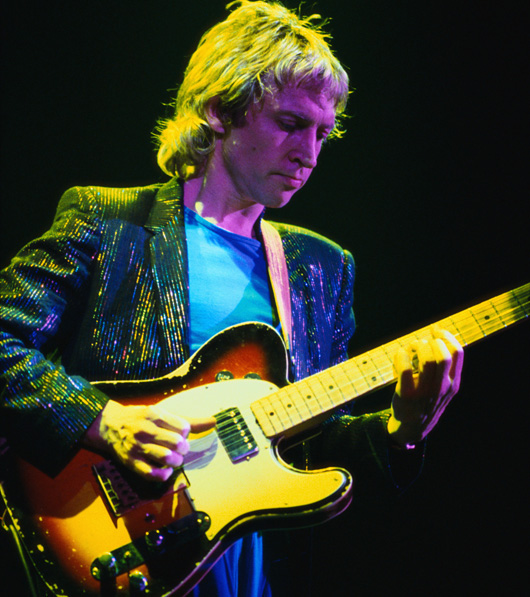
Andy Summers
Two years before the world heard of The Edge, Andy Summers began creating fascinating, spacey guitar sounds that are emulated to this day.
Unlike The Edge, however, who came to utilise numerous guitars, Summers stuck primarily to a Fender Telecaster, a ‘63 sunburst model that he bought in the early ‘70s for $200 from a student (he was teaching guitar at the time in Los Angeles).
With The Police, Summers matched his Tele (Gibson PAF humbucker in the neck, stock Fender pickup in the bridge, plus a preamp and an out-of-phase switch) with a vast array of effects (MXR Dyna Comp, Phase 90, Electro-Harmonix Electric Mistress Flanger, Roland guitar synths) on hits like Don’t Stand So Close To Me, Driven To Tears, Can’t Stand Losing You - the list goes on and on.
Check out this video in which Andy talks about Fender’s Andy Summers Tribute Telecaster.
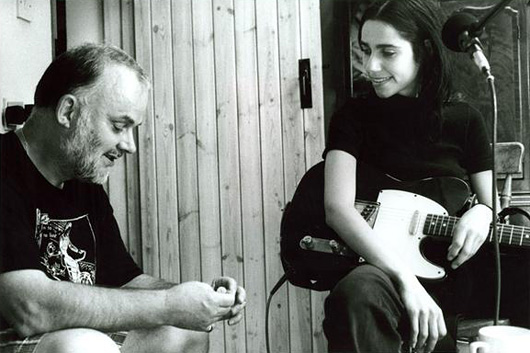
PJ Harvey
Polly Jean Harvey’s mixture of chiming chords and angular riffs couldn’t be more suited to the Fender Telecaster. Although Harvey uses a variety of guitars, collaborator John Parish’s black 1967 Tele which she borrowed for the lion’s share of her 1990s studio recordings is “closest to (her) heart”.
In 2000, after winning the Mercury Music Prize for her spellbinding Stories From The City, Stories From The Sea album, Harvey is believed to have purchased her own 1960s Telecaster. Here’s a great performance from that LP with a Telecaster providing the driving rhythm sound.

Steve Morse
Before he became the latest (and presumably last) lead guitarist for veteran hard rockers Deep Purple, Steve Morse established himself as an astonishingly gifted and versatile picker with the genre-defying instrumental group Dixie Dregs (later shortened to The Dregs).
Throughout most of his career, Morse relied on a Frankenstein Tele which boasted more mods than you can shake a headstock at. The neck is from a ’67 Stratocaster and the body is an early ’60s Tele. It came with a Gibson 335 neck position pickup. From there, it was anything and everything: Morse installed a Strat single-coil pickup, the original Fender chrome neck position pickup that was in the guitar case - and next to that he placed a Fender humbucker (later replaced with DiMarzio 'Steve Morse' model pickups). The man liked to tinker.
A special selector switch was then necessary to allow the guitarist to choose between pickup combinations. A lot of drilling and chiseling? Believe it. By the late ‘80s, Morse collaborated with Ernie Ball/MusicMan for a guitar that would combine all the elements of his one-of-a-kind Tele.
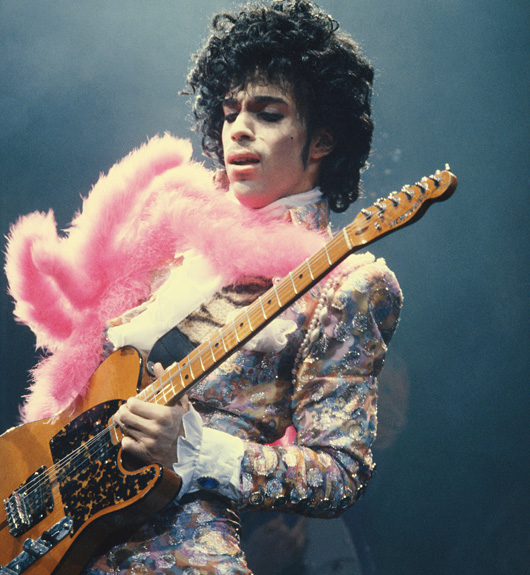
Prince
In the late ‘70s, Prince Rogers Nelson fell in love with Telecasters - only they weren’t true Teles; they were ‘Tele’-style guitars made by Hohner.
With the 1984 movie Purple Rain, the world came to know Prince as a superstar performer and dazzling axeman. Who can forget the scene where His Royal Badness jumps up on an amp, points his guitar at the crowd and lets his instrument ‘ejaculate’?
That guitar, as it turned out, was a prop. But for the Purple Rain tour, Roger Sadowsky was called in to create two playable clones of the prop ‘Tele.’
“I called them ‘Ejac-u-casters,’ Sadowsky jokes. “They were exact to the original: flamed maple top, ash body, walnut strip running down the middle, stock Tele pickups. The only difference was the copper tubing running alongside the truss rod that ran into a cavity of the guitar at one end and termintated at the headstock. Prince could activate a switch and shoot out the liquid.“
And just what was that up-till-now secret liquid? Inquiring minds want to know. Sadowsky doesn't disappoint: “Ivory dish detergent," he says with a laugh. "Simple as that."

Syd Barrett
Syd Barrett’s sporadic guitar work with Pink Floyd offers a classic showcase of Telecaster tone – from brash, ringing chords to glassy, piercing lead lines.
Barrett had two main Teles. His famous mirror-disc guitar was actually a Fender Esquire which he covered in silver sticky-back sheeting and thin metal discs (the same kind Jimmy Page also used to adorn his guitar).
Syd also had a double-bound ‘60s Tele Custom in black, notable for its maple fingerboard – a factory option from the late ‘60s onwards but less common than rosewood. The headstock’s CBS-style Fender logo confirms that at the neck (at least) was manufactured after CBS bought the company in late ’65. Whether the body is earlier and the neck added by Syd or the whole guitar just a rare stock option is the subject of speculation.
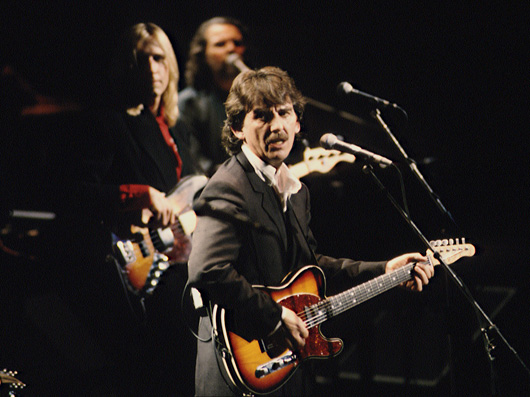
George Harrison
In December 1968, a prototype Rosewood Telecaster was hand-delivered to the Apple offices in London after being flown across the Atlantic in its own seat. Harrison’s Rosewood Tele would become iconic for its use throughout the Get Back sessions and during The Beatles’ final performance on the roof of their Apple HQ on 30 January 1969.
Fender planned to launch a Rosewood Telecaster alongside a Rosewood Stratocaster, with Harrison and Jimi Hendrix the intended recipients. While George’s brief, but significant patronage ensured that a production model would follow, the Stratocaster took longer to complete and Jimi never received it, thus it never got past the prototype stage.
Harrison wasn’t the only Beatle to use a single-cutaway Fender; in 1966, Paul McCartney bought a right-handed sunburst 1964 Esquire which would be strung lefthanded and used during the Sgt. Pepper’s Lonely Hearts Club Band sessions on Good Morning, Good Morning. It has also been speculated that this was the guitar Paul used to record Helter Skelter.
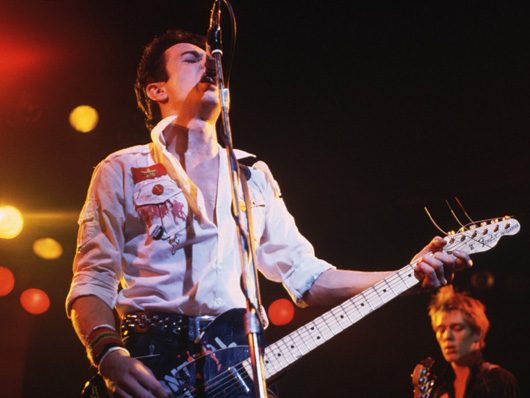
Joe Strummer
Unlike his more technically proficient bandmate in The Clash, Mick Jones, John Graham Mellor was strictly rhythm, hence his stage moniker, Joe Strummer.
The ‘sour’ to Jones’s ‘sweet,’ Strummer was a Tele man all the way, and he played it like a weapon, driving the band with a fervor that bordered on demonic possession. His axe of choice was a ‘66 sunburst that he painted black.
Aside from a bridge with individual saddles and six ’F’-style tuners, Strummer made little in the way of modifications. But he changed its look often: the word ’NOISE’ was stenciled on the upper part of the body, an ’Ignore Alien Orders’ sticker was placed above the bridge, a rasta flag sticker was affixed at the horn of the pickguard and a large question mark was spray-painted on the back of the instrument.
Strummer continued to play his ’66 Tele right up to his untimely death at the age of 50 in 2002.
Click here for 28 Telecaster legends: part 2
MusicRadar is the internet's most popular website for music-makers of all kinds, be they guitarists, drummers, keyboard players, DJs or producers.
GEAR: We help musicians find the best gear with top-ranking gear round-ups and high-quality, authoritative reviews by a wide team of highly experienced experts.
TIPS: We also provide tuition, from bite-sized tips to advanced work-outs and guidance from recognised musicians and stars.
STARS: We talk to artists and musicians about their creative processes, digging deep into the nuts and bolts of their gear and technique. We give fans an insight into the actual craft of music-making that no other music website can.
